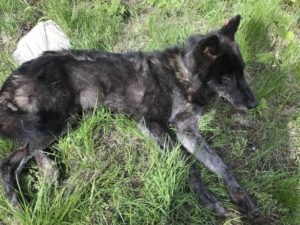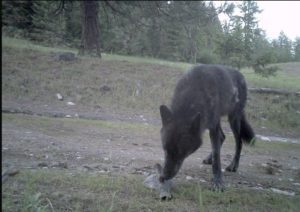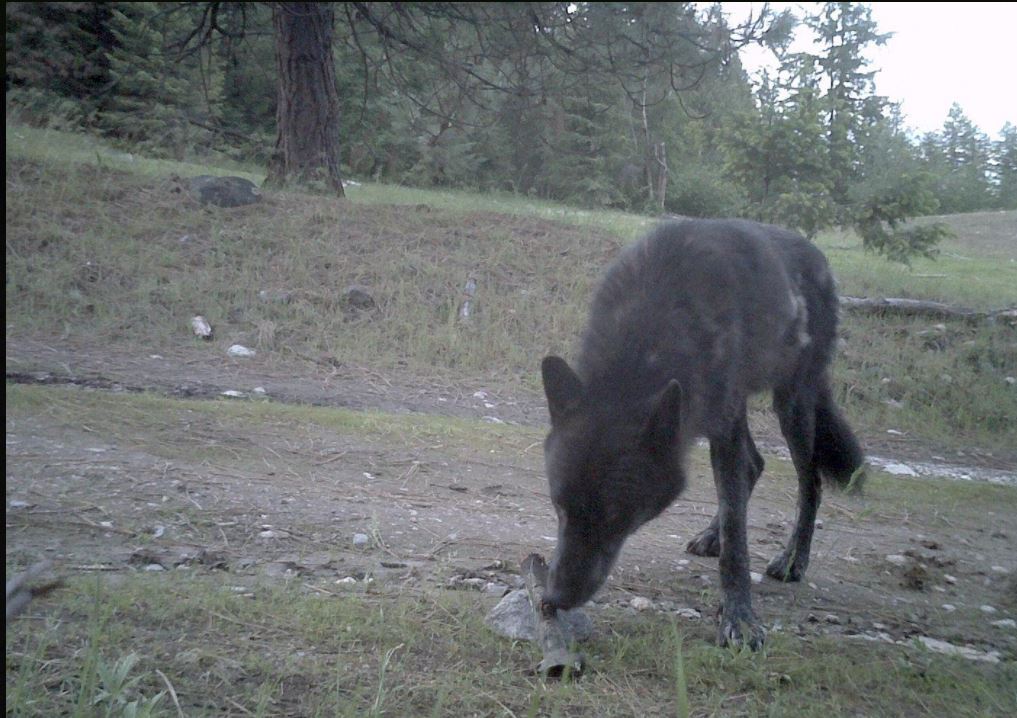The clock has run out on the Washington Department of Fish and Wildlife’s latest attempt to kill the state endangered gray wolves that are members of the Togo Pack in northeastern Washington.
Once again, the Togo Pack has managed to escape destruction at the hands of taxpayer-funded gunners. The latest kill order from the Washington Department of Fish and Wildlife expired Sunday, with the Department failing to kill any Togo wolves. The Togo wolf family has been targeted by the Department five times since the pack was first identified in 2018. Yet to date, the Department has only succeeded in killing one Togo wolf—the father of the initial pack, which the Department killed in 2018 after he had been crippled by a livestock owner’s gun.
Once again, the kill order has proven unnecessary. For the third year in a row, predations on cattle ceased after the state started trying to kill the Togo wolves. On Monday, a Department spokesperson confirmed that the agency had not documented any livestock attacks by Togo wolves in 40 days. Department representatives speculate that this may be due to the increased human presence and disruption caused by its officers in the field hunting Togo wolves—which, of course, could have been accomplished without attempting to kill wolves.
Once again, the Department has refused to learn from past mistakes. The Department continues to issue kill orders against packs after conflicts that were entirely predictable—and avoidable. Documents obtained from a public disclosure request show that cattle were turned out directly onto the Togo family’s den and rendezvous sites, and that both the Department and the producer knew of this overlap, but allowed it to continue even after conflicts began. The Department seems doomed to repeat this futile pattern in an endless loop, until it learns from past mistakes.
Video from a trail camera shot in the summer of 2018 shows the original father of the Togo family with two of his pups. A short time after this video was shot, a livestock producer followed GPS signals from the Togo father’s radio collar to the pack’s den, and shot the Togo father after he reportedly growled to defend his pups. The shot shattered one rear leg, but the wolf survived and stayed with his pack—until the Department succeeded in overturning a court order and killed him several days later.
Kill Order Shows Eagerness to Target Togo Pack
WDFW Director Kelly Susewind issued the latest order to kill Togo wolves on August 26, 2021, after the Togo Pack was blamed for injuring three calves. WDFW investigators decided that one other calf injury was “probably” caused by wolves.
These incidents barely met the minimum requirements for killing wolves under WDFW’s Wolf-Livestock Interaction Protocol, which requires evidence that a pack is responsible for 3 predations within 30 days, at least one of which must be a confirmed wolf kill. In this case, the only “kill” was a calf euthanized by a veterinarian who concluded that its injuries could not be treated—after they had been allowed to fester for at least three days while the injured calf remained on the grazing allotment.
Although WDFW has repeatedly assured the public that just meeting the Protocol’s minimum requirements will not trigger a kill order, this latest order shows, once again, that it will seize any excuse to resume its three-year campaign to eradicate the Togo Pack—the agency’s very own great white whale.

Despite frequent calls for greater transparency, the Department still refuses to make information about its kill orders public, rejecting repeated requests to make publicly available the team and regional recommendations that lead to its kill orders, or other materials such as range rider logs and reports from predation investigations. Indeed, the Department only furnishes timely information when advocates file a lawsuit—creating an incentive to sue just to obtain information that should automatically be public. Otherwise, advocates need to file public disclosure requests and then wait for weeks, months, and sometimes even years, for the Department to respond.
On the same day that Director Susewind issued the Togo kill order, we filed a public disclosure request for the recommendations and materials that led to that order. It took three weeks for the Department to make any meaningful response, at which time it finally sent us the District 1 Team Recommendation that was sitting in front of the Director on the day he issued his order. (We are still waiting for other materials, such as reports from predation investigations, which we are told we will not receive until December.)
This report adds more clarity to the disturbing events that led to the Togo kill order.
Producer Released Cattle onto the Togo Pack’s Doorstep
It is a fact pattern that will feel eerily familiar to those who followed the facts of the Department’s slaughter of the Profanity Peak Pack in 2016 or the OPT Pack in 2019: in 2020, a producer knowingly turned his cattle out on top of the Togo family’s den and rendezvous sites—and then kept them there, even after the conflicts began.
The District 1 Team Recommendation reveals that “Producer 1,” who owned two of the four calves injured by the Togo family, turned his cattle out onto a U.S. Forest Service grazing allotment even after WDFW informed him that it contained both a den and a rendezvous site, creating “direct overlap with the cattle and wolves.” The Recommendation also makes clear that the producer then failed to keep his roaming cattle away from the den and rendezvous sites, where the five adults in the Togo Pack were attempting to raise four pups.
Wolves keep their pups in dens for the first few weeks of their lives, and then move them to rendezvous sites when they are about eight weeks old, where the pups will wait while most of the adults are out hunting. As WDFW biologists and other experts have acknowledged, the presence of cattle at wolf den and rendezvous sites is one of the primary predictors of potential conflict. WDFW’s 2011 Wolf Conservation and Management Plan highlights this problem—indeed, its second recovery objective is to “protect wolves from sources of mortality and disturbance at den sites.”
Yet the Recommendation shows that the Forest Service, WDFW, and the producer just threw up their collective hands, allowing cattle to be grazed directly on top of these core wolf areas, even when conflict seemed inevitable.
The Forest Service controls the grazing allotment on which the Togo Pack den and rendezvous sites are located, but it did not close that allotment to grazing after these core wolf areas were discovered, open any other alternative allotments to the producer, or require the producer to keep his cattle away from core wolf sites as a condition of continuing to use the allotment.
The Department identified the core wolf sites, but it did not work with the producer to make sure his cattle did not graze there. In fact, the Recommendation notes that due to the “lack of available feed and forage,” the producer will continue to graze his cattle in these areas through October. If WDFW had made this overlap known before there was a conflict, however, there might have been a variety of solutions to the problem—for example, numerous nonprofit entities no doubt would have been willing to raise money to purchase feed for the producer to allow him to keep his cattle in his home pastures. Instead, WDFW just sat passively by and watched the conflict unfold, and then wasted tens of thousands of taxpayer dollars in yet another effort to kill state endangered wolves.
The producer knew about the den and rendezvous sites, but he turned his cattle out onto them anyway. And although the producer has a “large and contiguous range” on which he grazes his cattle, he failed to control his herd to keep them away from these core wolf areas even after turnout, instead leaving them “free to roam through the whole pasture.”
Indeed, while the producer was apparently offered several range riding services, he appears to have used those services either primarily, or perhaps, exclusively, to pay members of his immediate family. The Recommendation notes that both the northeastern Washington Wolf-Cattle Collaborative (NEWWCC) and the Cattle Producers of Washington (CaPOW) paid the producer and members of the producer’s own family to “range ride” their own cattle. Whatever “range riding” resulted from this expenditure of resources was clearly not sufficient to control or protect the producer’s cattle.
WDFW Continues to Turn Prime Wolf Country into a No Wolf Zone
The Togo Pack makes its home in the Kettle River Range in the Colville National Forest. The Kettle River Range is prime wolf country: a rugged, heavily forested, and largely-impassable wilderness. It is also an area that is largely unsuitable for cattle grazing. A recent Forest Service analysis found that, on average, only 30% of the territory within each of the five allotments that make up the Togo Pack’s range is suitable for cattle grazing.

Yet the Forest Service continues to allow producers to turn cattle out into this area, where forage is sparse—especially in a drought year like 2021. Densely wooded areas and steep mountainsides make it impossible for cattle to bunch together for safety, and downed trees create “traps” that render cattle helpless and unable to escape.
To any sane observer, the obvious solution would be to stop grazing cattle on public forest lands that provide ideal habitat for wolves, cougars, and bears. But WDFW’s solution has been the opposite—to regularly exterminate all the wolf packs in this area (as well as many other species of carnivores), to try to make these wild forests “safe” for cattle.
In essence, WDFW is turning this prime wolf country into a no wolf zone.
But it gets even worse. The Togo Pack territory was the only area this season that qualified as a “chronic conflict area,” under a pilot program through which WDFW was supposed to direct new resources to areas it has issued kill orders in past years, and work with producers to come up with a plan for avoiding future conflict in those areas. Nevertheless, the Recommendation indicates that many components of this pilot plan were discussed but were “not able to be implemented this summer.”
The elements of the plan that could not be implemented included such basic and obvious strategies such as keeping cattle away from wolf den and rendezvous sites, and calving away from wolf-occupied areas—because carnivores are attracted to calving locations, and newborn animals are more vulnerable. Although WDFW claims Producer 1 has “traditionally” calved away from wolf-occupied areas and “most” of his calves were born off the range, the Recommendation also notes that one of the four injured calves had been born out on the range—as many other calves undoubtedly were, as well.
The Department did briefly deploy one new technique under the pilot program that seems to have worked—during the brief time that it was in place. The Department installed a radio-activated guard device (RAG Box) around the cattle, which is designed to pick up on the signal from the one collared wolf in the Togo Pack, and set off sounds like explosives and gunfire when that wolf approaches.
The RAG Box was in place in between June 25 and August 5, a time period during which there were no reported predations. On August 5, however, the Department inexplicably concluded that the RAG Box was “ineffective,” and removed it to put it in another pasture. Notably, all the predations blamed on the Togo Pack were recorded either before the RAG Box was in place, or after it was removed.
Department Claims it Could Kill Togo Pack and Another 38 Wolves this Year
Even if killing state endangered wolves is unnecessary and ineffective, the Department seems to contend that it is nonetheless acceptable, as long as it will not damage the state wolf population to such a degree that it precludes recovery.
WDFW continues to advance the ridiculous notion that killing one or two members of a pack will “change pack behavior,” causing the pack to learn its lesson and stop preying on cattle. The Department would have us believe that surviving wolves will somehow draw a correlation between a meal they had days, if not weeks, earlier, and the death of one of their packmates at the hands of a Department gunman, usually at a distant location. Not surprisingly, the Department has never produced any science to support this idea, which anybody with a dog knows to be absurd.
Yet, even though the weight of the science shows that killing wolves does not alleviate cattle-wolf conflicts, the Department is always ready to give killing a try, as long as it can claim that doing so will not “jeopardize wolf recovery.”
This callous calculation ignores the fact that wolf packs are really wolf families, which function as a unit in hunting prey and raising their young, and that killing even one member of the family disrupts its social structure. This disruption will often lead to additional conflict as the pack adjusts to its loss.

Nevertheless, WDFW still justifies its kill orders through a pure numbers game—leading the Recommendation to conclude that even if the Department were to kill all known wolves in the Togo territory, it could still kill another 22 to 38 state endangered wolves this season and stay within an acceptable range.
This is the same kind of disturbing mentality that has led neighboring Idaho to conclude that it can kill 90% of its wolf population, as long as it does not kill them all, and Wisconsin to decide that it is appropriate to eradicate roughly 70% of its population to reach a state population “goal” of 350 wolves.
WDFW’s numbers also do not add up as a matter of common sense. At last count, Washington has only 132 wolves in 24 packs. The loss of any of these wolves is a significant blow to a recovering population. Although WDFW considers the northeast part of the state to be “saturated” with packs, it acknowledges that such “saturation” is necessary for wolves to disperse to other areas of the state—which must happen before the wolf population can meet recovery goals in all three regions of the state.
And the Department knows that even if it kills the entire Togo Pack this year, it will not prevent conflict next year.
The Togos occupy prime wolf country, and if the current pack is eradicated, another pack will inevitably move in to claim that territory next year. We have seen this happen year after year in the neighboring wolf territory in the Kettle River Range—which was first occupied by the Profanity Peak Pack in 2015-2016, then the Sherman Pack in 2017-2018, the “Old Profanity Territory” Pack in 2019-2020, and now the Kettle Pack.
As WDFW has eliminated one wolf pack, another has inevitably come in to take its place.
Togo Pack Will Remain One Injured Cow Away from Another Sentence
Although the Togo Pack has been granted a brief reprieve, neither WDFW nor the producers have addressed any of the underlying issues that led to the conflict, and at least one producer plans to continue grazing his cattle in the Togo territory through October. Whether it is during the next month or next year, we agree with one of the cattle producers who was quoted in a local publication as saying that this problem is “not going away.”
In fact, the Togo family will remain one injured cow away from another potential kill order until June 6, 2022, thanks to a senseless portion of the Department’s Wolf-Livestock Interaction Protocol that allows for a kill order if a pack is blamed for 4 predations within 10 months. The Department continues to use this provision to kill wolves, even though it has never produced any evidence of a relationship or behavioral connection between a conflict occurring today and one that might occur 10 months from now, after the winter, when the pack will likely include different wolves, and be established in a different area.
Indeed, the Protocol will allow WDFW to continue to try to kill Togo wolves even if no additional measures are put in place to try to separate cattle from wolves, or to prevent the inevitable conflict that will result from this overlap.
This is just one more example of how the Department uses its Protocol as cover for its attempts to appease wolf opponents under the guise of promoting “social tolerance” for wolves. These attempts inevitably fail, as WDFW can never kill enough wolves quickly enough to satisfy that powerful lobby, which recently objected that the Togo kill effort merely amounted to “another broken promise.”
The Togo Pack kill order is thus another prime illustration of why we need a rule with enforceable standards to regulate when WDFW can kill wolves. Governor Jay Inslee ordered the Fish and Wildlife Commission to consider such a rule in September 2020. After more than a year of delays, WDFW expects that it will finally propose a draft rule for consideration in January.
We all need to work to ensure that the current rule-making process results in a program that will provide better protections for our endangered wolf population.
The survival of the Togo Pack depends upon it.
